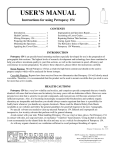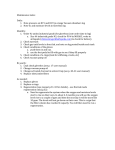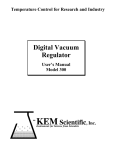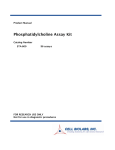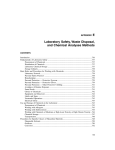Download COP group, Sciences Chimiques de Rennes, UMR 6226 1
Transcript
COP group, Sciences Chimiques de Rennes, UMR 6226 JACOMEX GLOVEBOX in JFC’s group Brief user manual This document has been written to explain briefly how to operate with glovebox including some general policies, rules and precautions. Please, respect them for your own benefit. General policy. Using glovebox you can easily and effectively manipulate with very sensitive compounds and reagents under argon atmosphere. The contamination of the inner atmosphere with oxygen and water is presented by two sensors at the top of the box (usual contamination shouldn’t exceed 2 ppm for O2 and 5 ppm for H2O). In order to introduce your stuff inside the glovebox you can use any of the two ports (big or small) depending on the quantity and size of your equipment. Using the big port. 1) disconnect the port from the vacuum pump. 2) fill the port with air by opening the outlet on the top. 3) place your stuff into the chamber of the big port 4) connect port with the vacuum pump by opening slowly the valve. 5) keep on pumping out the big port at least for 30 minutes before introducing your stuff inside the glovebox. Using the small port. 1) disconnect the port from the vacuum pump. 2) fill the port with argon from the glovebox. 3) place your stuff into the chamber of the small port 4) connect port with the vacuum pump by opening slowly the valve. 5) keep on pumping out the small port at least for 10 minutes before to introduce your stuff inside the glovebox. Nota Bene. To avoid the contamination of the inner atmosphere by traces of oxygen and water you should refill the port you use with argon atmosphere from the glovebox (~ 0.5 atm according to manometer) after you started pumping out (15‐20 minutes for the big port and 5 minutes for the small one). After you finished your work you have to connect the port you used to the vacuum pump. Rules and precautions. 1) The common regime of the glovebox is switched ON. Never turn it off ! 2) You should look carefully after the amount of argon in the gas cylinder. After it’s been exhausted (even less than 5 atm), please change the cylinder. 1 COP group, Sciences Chimiques de Rennes, UMR 6226 3) After the work with the glovebox is finished both of the ports should be connected to the vacuum pump and the light inside should be switched off. 4) There are several chemicals which are prohibited to be introduced inside the glovebox: H2O and alcohols, pyridine, chlorinated solvents. 5) It is imperative that before introducing inside any solvent must be purified and degassed. 6) To avoid the damage of the rubber gloves, please wear cotton gloves on your hands. Also, to protect the rubber gloves from the chemicals inside the glovebox you should use plastic gloves. 7) Do not introduce or use sharp things (needles, scalpels, scissors etc) inside the glovebox. Please try not to break any glassware inside the glovebox. 8) Before introducing inside the glovebox glassware such as Schlenks, NMR tubes, pipettes etc should be kept in the oven for several hours. 9) All the compounds inside the glovebox should be in the labeled vessels or flasks closed with stoppers. All the solvents (THF, pentane, toluene, benzene, hexane) must be stored in the special vessels equipped with the Teflon valves. 10) After working inside the glovebox, please use special paper to clean your spatulas or instruments. 11) At the end of the day, before leaving the lab, do not forget to switch OFF the vacuum pump and turn OFF the light !!! The catalyst in the purification line should be regenerated every 4‐5 months. SOLVENTS & CHEMICALS FORBIDDEN FOR USE IN THE GLOVEBOX ‐ protic solvents/chemicals (water, acids) ‐ any ALCOHOLS or AMINES or EPOXIDES ‐ any chlorinated solvents (CH2Cl2, CHCl3, C6H5Cl etc) THESE HOSTILE AND AGGRESSIVE CHEMICALS SHOULD BE HANDLED WITH SPECIAL CARE ‐ coordinating solvents (THF etc) ‐ liquid polar monomers (acrylates, lactones, carbonates) 2


